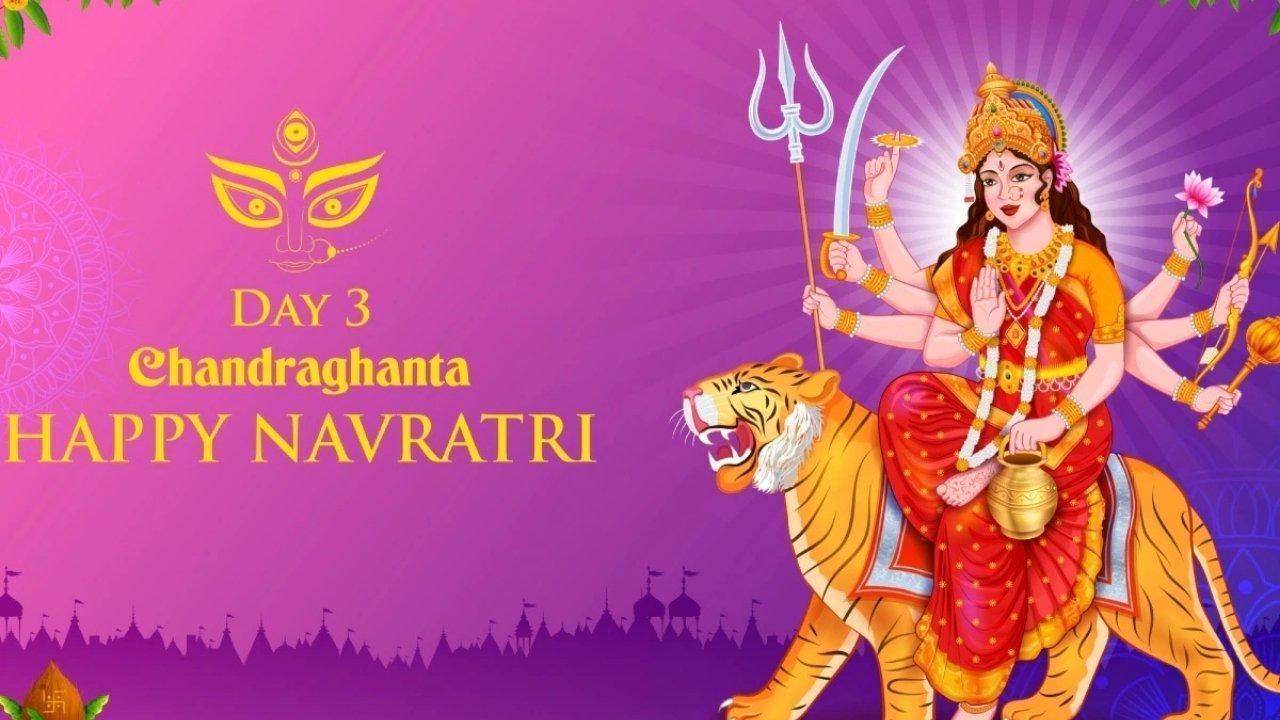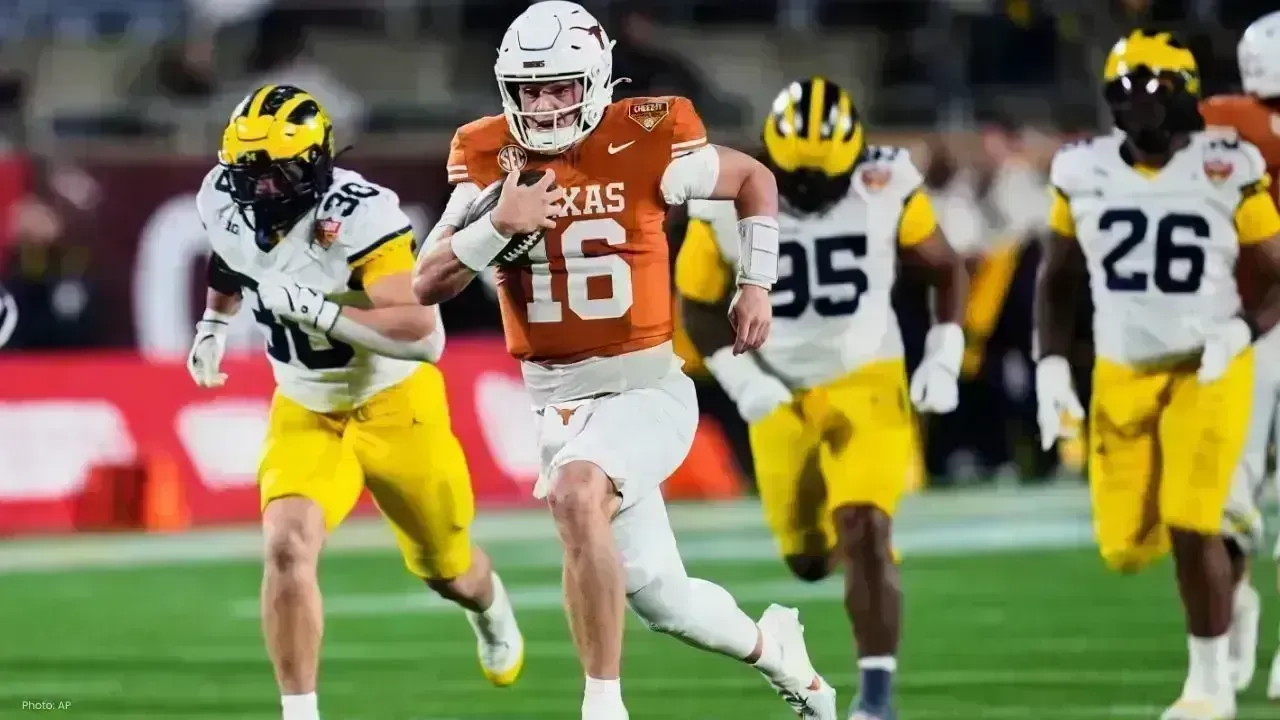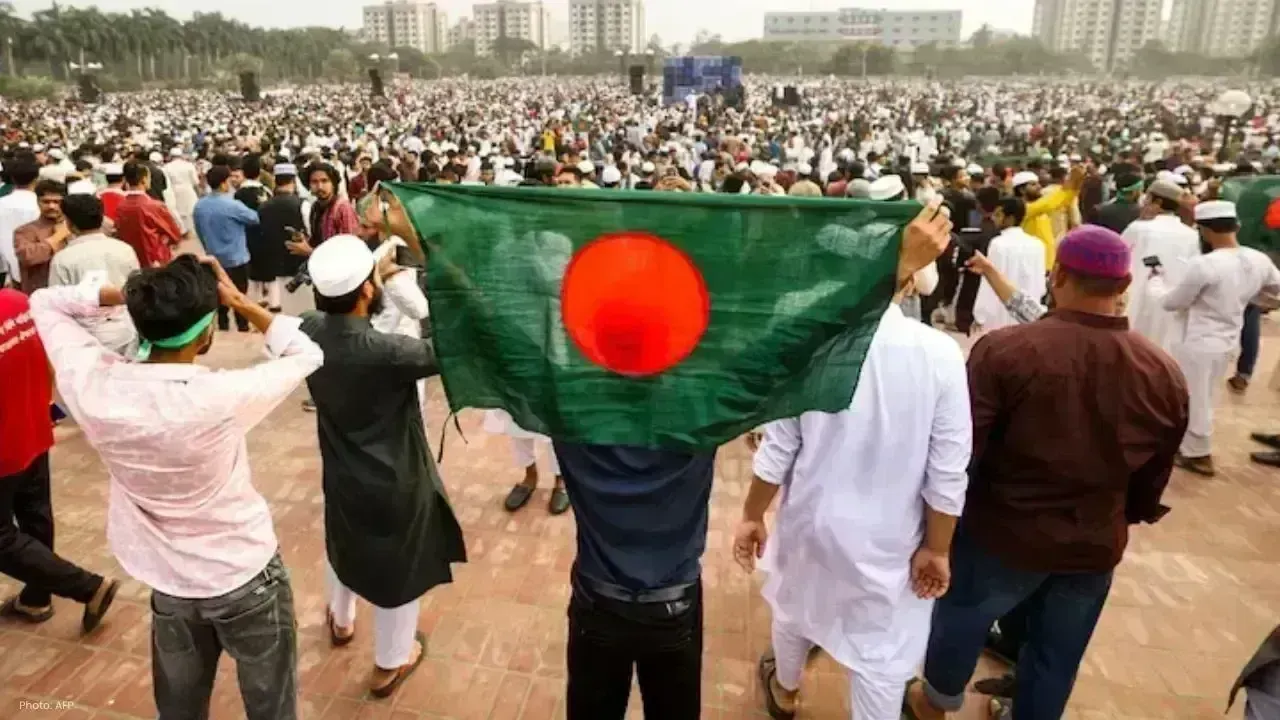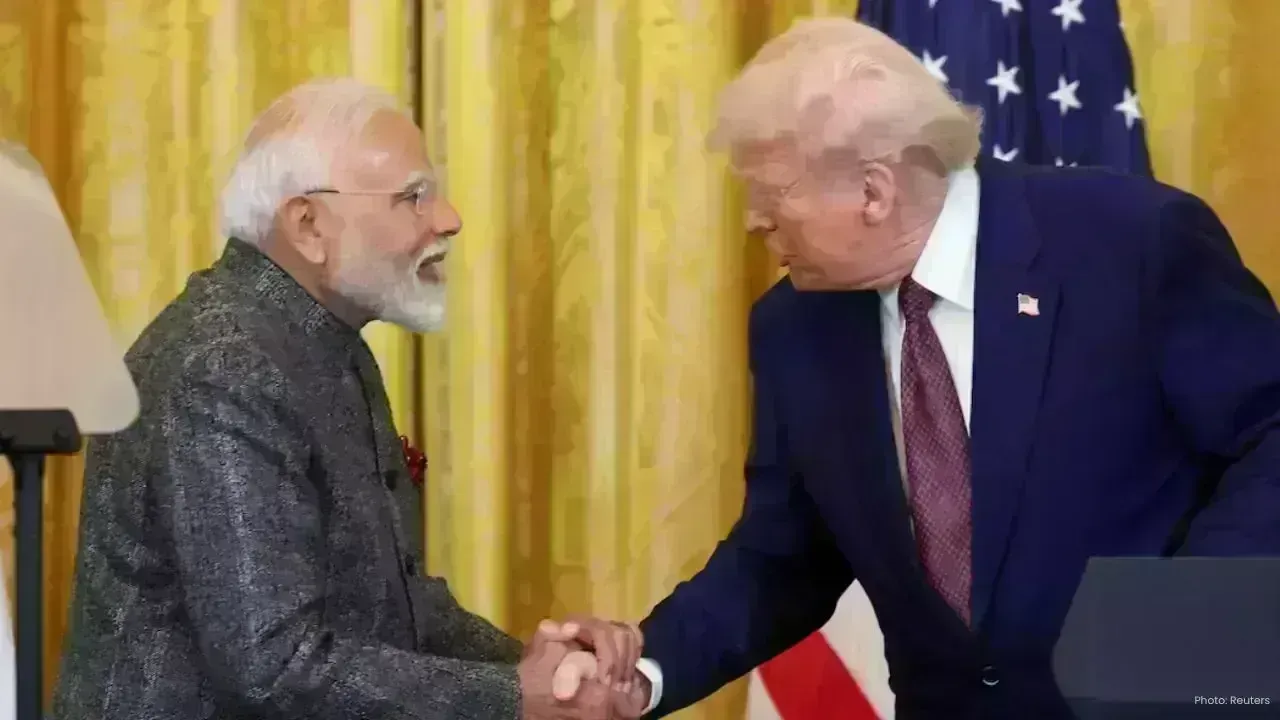You have not yet added any article to your bookmarks!

Join 10k+ people to get notified about new posts, news and tips.
Do not worry we don't spam!

Post by : Anis Farhan
Navratri is one of the most celebrated Hindu festivals, observed over nine nights and ten days, dedicated to the nine divine forms of Goddess Durga. Each day holds a distinct importance, symbolizing a different manifestation of the Goddess. The third day of Navratri is dedicated to Goddess Chandraghanta, who represents courage, grace, and peace. She is revered as the destroyer of demons and the one who brings harmony into the lives of devotees.
The Goddess gets her name from the crescent moon (Chandra) on her forehead shaped like a bell (Ghanta). This symbolizes tranquility, bravery, and spiritual awakening. On this day, devotees pray to her for strength, courage, and relief from suffering, both external and internal. The energy of Day 3 is often associated with balance, urging devotees to combine bravery with calmness in their personal and spiritual lives.
Goddess Chandraghanta is the third manifestation of Goddess Durga. She is depicted as a warrior goddess, riding a tiger or lion, signifying bravery and power. Her ten hands carry weapons such as a trident, sword, mace, bow, arrow, and lotus, while her posture radiates a calm yet fierce presence.
She embodies both gentleness and valor. While her bell-shaped crescent moon exudes peace, her weaponry and tiger mount portray her readiness to fight evil forces. This duality makes her one of the most relatable forms of the Goddess, as she teaches humans to strike a balance between gentleness and strength in daily life.
Navratri Day 3 signifies the importance of courage in overcoming fears and difficulties. Worshipping Goddess Chandraghanta is believed to eliminate suffering, obstacles, and negative energies from one’s life. Devotees believe that by offering prayers, they attain peace of mind, emotional stability, and bravery to face life’s challenges.
On a spiritual level, Day 3 is associated with the Manipura Chakra, also known as the solar plexus chakra. This chakra governs confidence, energy, and personal power. By meditating on Goddess Chandraghanta and chanting her mantras, devotees seek to awaken this energy center, thus enhancing their inner strength and determination.
Day 3 of Navratri is filled with sacred rituals that hold deep meaning for devotees. These practices vary across regions, but some common customs include:
Morning Prayers and Fasting: Devotees wake up early, bathe, and perform prayers dedicated to Goddess Chandraghanta. Many observe fasts, consuming only fruits, milk, or light meals.
Offering Flowers and Prasad: Red flowers, milk, sweets, and fruits are offered to the Goddess. Red is considered an auspicious color on this day, symbolizing courage and power.
Chanting Mantras: Devotees chant her mantra, "Om Devi Chandraghantayai Namah," which is believed to bring peace and ward off negativity.
Decorating Homes and Temples: Homes and temples are decorated with lights, flowers, and rangoli to welcome the Goddess’s blessings.
Community Gatherings: In many parts of India, cultural programs like Garba and Dandiya Raas are performed, where people celebrate the divine energy through dance and music.
Every day of Navratri is associated with a particular color that carries its own symbolism. The color for Day 3 is royal blue or sometimes red, depending on regional customs.
Royal Blue: Represents calmness, trust, and the vastness of life. Wearing this color during prayers helps devotees channel inner peace.
Red: Symbolizes power, energy, and strength, directly reflecting the qualities of Goddess Chandraghanta.
The color chosen on Day 3 is not only a part of the ritual but also a reminder of the divine energy that the Goddess embodies.
Navratri is celebrated differently across regions, and Day 3 takes on unique shades of tradition:
In North India: Temples host special pujas, and the recitation of Durga Saptashati is common. Many households perform Kumari Puja, where young girls are worshipped as embodiments of the Goddess.
In West India (Gujarat and Maharashtra): The vibrant Garba and Dandiya nights are in full swing. Devotees wear royal blue or red attire and dance in circles to honor the Goddess.
In East India (West Bengal, Assam, Odisha): Though the focus is on Durga Puja, the third day marks the rituals of Maha Saptami, where Goddess Chandraghanta is invoked with elaborate ceremonies.
In South India: Families create Golu displays with idols and figurines, while devotional singing and lamp-lighting rituals are performed.
One of the popular legends associated with Goddess Chandraghanta is her role in combating the demon Mahishasura. When Mahishasura created havoc, the Goddess appeared in her Chandraghanta form, ready for battle. With her ferocious energy and calm determination, she defeated demons and restored balance in the universe.
Another story highlights her role as a protector of her devotees. It is believed that her bell-shaped crescent emits a sound that drives away negative energies and evil spirits, symbolizing the removal of fear from human life.
These stories reinforce her image as both a gentle mother and a fierce warrior, reminding devotees that strength and compassion can coexist.
Fasting on Day 3 is not just a ritual but also a spiritual discipline. By controlling food intake, devotees focus on purifying the body and mind. Some consume only milk, fruits, or water, while others follow a satvik diet that excludes onion, garlic, and grains.
The essence of fasting lies in self-control and spiritual focus. It is believed that abstaining from indulgence helps channel energy towards prayer and meditation, thereby inviting the blessings of the Goddess.
In today’s fast-paced world, the teachings of Goddess Chandraghanta remain highly relevant. She teaches us the importance of bravery in facing adversities and maintaining peace in difficult times. People interpret her presence as a reminder that life requires both inner strength and calmness.
Navratri Day 3 also inspires communities to come together. The dances, music, and cultural festivities during this time create unity and joy, bridging generations and social differences.
On this day, devotees prepare offerings such as milk, sweets, kheer, and jaggery-based dishes. Prasad is first offered to the Goddess and then distributed among family members and community gatherings. The idea is to share the divine blessings and spread joy among all.
Popular dishes for Day 3 include:
Sabudana khichdi
Coconut ladoos
Kheer (rice pudding)
Singhara flour halwa
These foods not only serve as sacred offerings but also connect devotees through shared traditions and family bonding.
Navratri is incomplete without music and dance. On Day 3, people wear bright attire and gather in large groups to perform Garba and Dandiya Raas. These dances are not just forms of entertainment but are symbolic of spiritual celebration, where every move pays homage to the Goddess.
The rhythmic beats of drums, claps, and sticks reflect the energy of Goddess Chandraghanta, filling the atmosphere with joy and divine vibrations.
Worshipping Goddess Chandraghanta on Day 3 has a profound psychological effect. The rituals and prayers instill confidence, remove fear, and encourage positivity. Many devotees believe that the sound of bells, chants, and mantras create vibrations that calm the mind and reduce stress.
The celebration also fosters emotional healing, as the sense of community, shared devotion, and cultural participation create a feeling of belonging and purpose.
Though rooted in Hindu traditions, the teachings of Day 3 transcend religious boundaries. The values of courage, balance, and peace are universal. Many people, regardless of faith, participate in Navratri celebrations to experience cultural richness, joy, and spiritual energy.
It has also become a global celebration, with Indian communities abroad organizing Garba nights and cultural events, introducing others to the significance of this day.
Navratri Day 3, dedicated to Goddess Chandraghanta, symbolizes the union of strength and peace. She teaches us to fight negativity with courage while maintaining serenity in life. The rituals, fasting, cultural festivities, and devotion observed on this day continue to inspire millions around the world.
Her crescent moon, resembling a bell, is not just an ornament but a symbol of divine vibrations that protect, heal, and guide devotees. By embracing her teachings, individuals can lead lives filled with bravery, balance, and devotion.
This article is intended for cultural and informational purposes only. Rituals, fasting methods, and practices may vary depending on regional traditions and personal beliefs. Readers are encouraged to follow their family customs or consult religious guides for specific practices.










Kim Jong Un Celebrates New Year in Pyongyang with Daughter Ju Ae
Kim Jong Un celebrates New Year in Pyongyang with fireworks, patriotic shows, and his daughter Ju Ae

Dhurandhar Day 27 Box Office: Ranveer Singh’s Spy Thriller Soars Big
Dhurandhar earns ₹1117 crore worldwide by day 27, becoming one of 2026’s biggest hits. Ranveer Singh

Hong Kong Welcomes 2026 Without Fireworks After Deadly Fire
Hong Kong rang in 2026 without fireworks for the first time in years, choosing light shows and music

Ranveer Singh’s Dhurandhar Hits ₹1000 Cr Despite Gulf Ban Loss
Dhurandhar crosses ₹1000 crore globally but loses $10M as Gulf nations ban the film. Fans in holiday

China Claims India-Pakistan Peace Role Amid India’s Firm Denial
China claims to have mediated peace between India and Pakistan, but India rejects third-party involv

Mel Gibson and Rosalind Ross Split After Nearly a Decade Together
Mel Gibson and Rosalind Ross confirm split after nearly a year. They will continue co-parenting thei